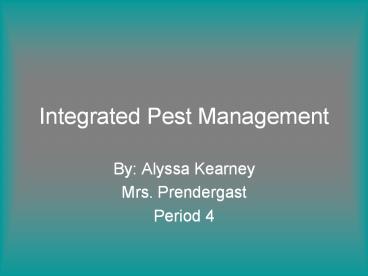Integrated Pest Management - PowerPoint PPT Presentation
Title:
Integrated Pest Management
Description:
Integrated Pest Management By: Alyssa Kearney Mrs. Prendergast Period 4 What & Why IPM is an agriculture pest control strategy where you use knowledge on the pests ... – PowerPoint PPT presentation
Number of Views:454
Avg rating:3.0/5.0
Title: Integrated Pest Management
1
Integrated Pest Management
- By Alyssa Kearney
- Mrs. Prendergast
- Period 4
2
What Why
- IPM is an agriculture pest control strategy where
you use knowledge on the pests living place, what
it does, and its history. - IPM helps control and terminate pest problems in
a smart way using what you have learned about the
pests.
3
The First Step
- Understand what the customer wants you to do with
the pest. - Consult the owner of the property and see what
they want done with the pest. Do they want it
dead? Do they care if you use chemicals? (etc.)
4
The Second Step
- Examine the pest and the problem
- Make sure you know which species are currently
there. Check buildings, make sure you have the
right identification, know characteristics of the
pest.
5
The Third Step
- Use short term actions to better control the pest
- If theres a lot of the type of pest, try using
insecticides first to get rid of some of the
pests. Do small things that will let you do the
big tactic more thoroughly.
6
The Fourth Step
- Use long term actions to rid the pest
- Use the tactics to help resolve the pest issue.
Prevent the pests from doing harm or coming back.
7
The Fifth Step
- Write records
- Remember to keep track of the strategy you used
to get rid of the pest. It might be helpful in
the future! Remember a conclusion.
8
The Last Step
- Consult the landowner again
- Tell the owner the process you used to rid the
pest. Make sure the customer stays informed about
what they can do to help control the pest in the
future (if it comes back).
9
The Six Tactics
- Chemical Control- There are special insecticide
sprays you can use to manage pests. You can spray
or lubricate where the pest is. - Biological Control- Predation (bringing in
predators to eat the prey) and parasitism (you
bring in another organism that gets benefits from
damaging the pest) - Physical Control- Using barriers, traps, weeding,
and getting rid of the pest using hands
10
The Six Tactics
- Cultural Control- Using sanitation, crop
rotations, and covering the crops to get rid of
the pest. - Regulatory Control- Take away things that make
the pest regulatory (i.e. health, comfort, and
recreation) - Exclusion- Place barriers and watch the pests
closely.
11
Bagworm
- Thyridopteryx ephemeraeformis
- The bagworm is native to Pennsylvania.
Bagworms on Colorado Blue Spruce
12
Recognizable Traits
- The pests reside in cone shaped figures. The
actual pest is shiny black with amber coloring on
their underside. Male bagworms turn into moths
that can fly around, while the women stay in the
grub form.
13
Life History of the Bagworm
- Bagworms start out as eggs. They grow into larvae
which look like moth larvae. They also go through
pupae. Then, as adults, women stay in a grub like
form while men grow into moths.
14
Winter Spring Summer Fall
Eggs stay in the bags the females made previously. Egg hatches and the larvae come out and search for food. Each one makes a bag around itself using silk and plant material. Feeding continues until August when they attach themselves to sticks and twigs. The pests stay there for about a month. Males leave their bags to go mate. They travel to the woman's bag where the woman can lay 500 to 1,000 eggs.
15
Impact
- Bagworms can eat both hardwood and softwood
trees. They usually attack fir, hemlock, juniper,
pine, and spruce. - Bagworms take away plant leaves, this causes leaf
damage. Attacks usually go unnoticed because
their bags look like pinecones.
16
Getting Rid of Bagworms
- You can just pick up the bag and burn it.
- Attract birds. Use birdfeeders or make your tree
desirable. - Use insecticides to spray on the pest to make
sure they die away.































